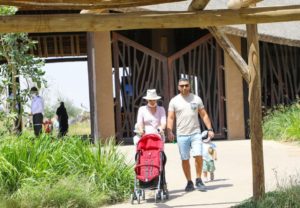Sharjah Safari Welcomes 23000 Thousand Visitors During First Month

The Sharjah Safari welcomed23,000 since it was officially opened by His Highness Sheikh Dr Sultan bin Muhammad Al Qasimi, Supreme Council Member and Ruler of Sharjah.
As the largest safari outside of Africa, Sharjah Safari has become a favourite destination for visitors who want to see and learn about more than 120 different species of animals. The Safari, which is located in the Al Bardi Reserve in the Central Region, provides a remarkable setting and is also home to more than 100,000 African Acacia trees.
HE Hana Saif Al Suwaidi, Chairperson of the Environment and Protected Areas Authority in Sharjah, said: “Sharjah Safari is a national treasure, and is not only the perfect case study for sustainable development but is one the Authority’s most important achievements. The Safari is the result of many years of work to help protect the environment, preserve nature and ensure the availability of resources for future generations. It constitutes an unparalleled natural destination in the region.”
The Chairperson added: “The Sharjah Safari is an incredible location for visitors, both young and old. It provides endless opportunities for lovers of animals and the environment to witness incredible sights from the natural world in real life, and also allows them to learn more about all areas of Africa and the amazing animals that live there.”
12 different environments
Sharjah Safari is home to 12 different environments, representing the different habitats and terrains in Africa,including the eastern coast of Africa by the Indian Ocean – which is the first environment at the Safari.
The second, is the Sahel region – represented by the desert, pastures and diverse wildlife. It extends from the Atlantic coast of Mauritania in the west, to Eritrea and the Red Sea in the east. It is a transitional area rich in wildlife between the Sahara in the north and the savannah to the south.
The savannah is the third region, which extends into eastern and southern Africa, from the coast in the north to the Kalahari in the southwest. This African tropical grassland covers half the continent’s area and is home to the largest concentration of biodiversity on Earth.
Next is the Serengeti, which celebrates the largest migration of animals in the world every year. The migration involves large groups of herbivores migrating through the Serengeti plains, attracting predators and animals that feed on carrion, crossing the Mara River, where Nile crocodiles lie in murky waters.
The fifth region, called Ngorongoro, is formed from an extinct crater and is a unique ecosystem home to some of Africa’s most iconic species.
While the sixth region, “Moremi”, was inspired by the canyons and valleys in southwest Africa, which were formed over centuriesby heavy seasonal rains. The region includes dry and sandy streams featuring aquifers that support life throughout the dry season.
Sharjah Safari is not only a tourist destination, but an important conservation and scientific project. Developed, supervised and monitored by EPAA, the Safari is working to breed many endangered species that are on the verge of extinction, with the end goal of releasing animals back into the wild – including rhinos, giraffes, Gazelles and birds.
Visual identity
Developing a world-class visitor destination has involved creating a striking brand and visual identity. The visual identity of Sharjah Safari features four endangered animals, the elephant, giraffe, lion and rhinoceros that appear in four different nature-inspired colours. This identity represents the core values of the Sharjah Safari, which are integration, diversity, corporate personality and international spirit. There is also an emphasis on the geometric pattern clearly visible in the shapes and lines.



